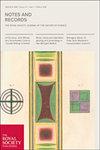维多利亚时代的电报:电报的早期发展及其与信件的相互作用
IF 0.6
3区 哲学
Q3 HISTORY & PHILOSOPHY OF SCIENCE
Notes and Records-The Royal Society Journal of the History of Science
Pub Date : 2018-01-10
DOI:10.1098/rsnr.2017.0031
引用次数: 4
摘要
这篇论文考察了维多利亚内陆电报的早期发展,更确切地说,是众所周知的电报。1870年电报国有化前20年,英国电报公司推出了第一项电报服务。有人认为,这项服务不如支撑它的电报技术那么创新。人们注意到电报和邮件服务之间的相似之处。为此,我们首先探讨了邮政通信的演变,重点是19世纪,当时邮件列车和邮票预付费等创新大大加快了邮件的速度,信件数量从1839年的6700万封增加到1865年的惊人的7.41亿封。电报服务就是在这种背景下向公众推出的。对电报公司提供这项服务所采用的运营模式进行了解构,以显示其与邮件服务的相似之处,并证明电报并不总是比信件更快。本文章由计算机程序翻译,如有差异,请以英文原文为准。
Victorian telegrams: the early development of the telegraphic despatch and its interplay with the letter post
The paper examines the early development of the Victorian inland telegraph, and more precisely the telegraphic despatches, or telegrams, as they became widely known. The first telegram service in Britain was launched by the Electric Telegraph Company two decades before nationalization of the telegraphs in 1870. It is argued that this service was not as innovative as the electric telegraph technology that underpinned it. Attention is drawn to the parallels between the telegram and mail services. To this end, the evolution of postal communication is first explored, with a focus on the nineteenth century, when innovations such as mail-trains and prepayment by stamp considerably accelerated the mail and increased the volume of letters from 67 million in 1839 to a staggering 741 million in 1865. It was in this context that the telegram service was introduced to the public. The operating model adopted by the Electric Telegraph Company to deliver this service is deconstructed to show the similarities with the mail service and to demonstrate that a telegram was not always faster than letter post.
求助全文
通过发布文献求助,成功后即可免费获取论文全文。
去求助
来源期刊
CiteScore
1.50
自引率
0.00%
发文量
45
审稿时长
>12 weeks
期刊介绍:
Notes and Records is an international journal which publishes original research in the history of science, technology and medicine.
In addition to publishing peer-reviewed research articles in all areas of the history of science, technology and medicine, Notes and Records welcomes other forms of contribution including: research notes elucidating recent archival discoveries (in the collections of the Royal Society and elsewhere); news of research projects and online and other resources of interest to historians; essay reviews, on material relating primarily to the history of the Royal Society; and recollections or autobiographical accounts written by Fellows and others recording important moments in science from the recent past.

 求助内容:
求助内容: 应助结果提醒方式:
应助结果提醒方式:


